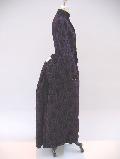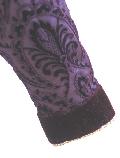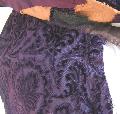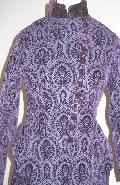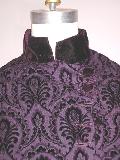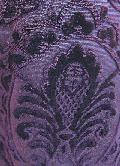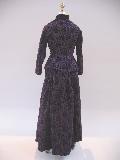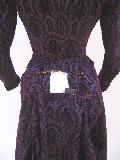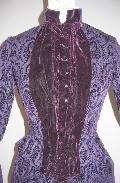The bodice, c. 1888, is constructed from beautiful purple silk brocade with a silk velvet overlay on the front. The base is made from purple faille which has a repeating pattern in velvet. This fabric has uncut loops woven into an intricate motif pattern. The velvet is a deep shade of purple. The solid velvet used for the cuffs, collar, and center front panel has a crisp base which is gray in color. A second bodice was found with the skirt. It is a larger size and was likely made at a later time. This analysis concerns the smaller, perhaps original bodice. Both bodices appear in Costar.
Bodice
Center front has a velvet overlay, 3" in width at neck and widening to 3 1/3" over the bust that is gathered to go into the collar and pleated at the bottom edge of the bodice. The velvet is cut on the bias and is hand stitched to the brocade from which the bodice is made. The thread used to attach this piece has deteriorated in several places, allowing the overlay to pull away from the base fabric. Due to the separation, it is possible to see that the base fabric does not extend all the way to the center front. The overlay is hand stitched in a few places to control the fullness. The front has only one dart to provide shaping from under the bust to the bottom edge of the garment. The shoulder seam does not sit at the top of the shoulder; rather, it falls approximately an inch to the back of the garment. The back of the bodice is comprised of two side and two center back pieces. It has a fiddle back shape with a very subtle curve. The center back seam provides additional shaping at the waist. The side back piece is created from two pieces of fabric with a small triangle inserted at the bottom. The center back pieces are damaged -- it appears as though a cut was made into the back to salvage the fabric. This cut edge leads one to believe that the garment once had tails at the center back with pleats on either side, typical of many bodices of the period. The bodice is flatlined to burnt sienna polished cotton.
The seams of the bodice are finished with hand overcast stitches. The dart seam allowance and side seam allowance are both clipped in a few places. The seam allowance is tacked to the flatlining at center back from the waist to the bottom of the garment. The bottom edge of the garment is finished with a 1 3/8" piece of solid purple velvet cut on the bias. This material is also used to finish the inside of the collar which stands 1 1/2" high. The bias is hand stitched on both edges.
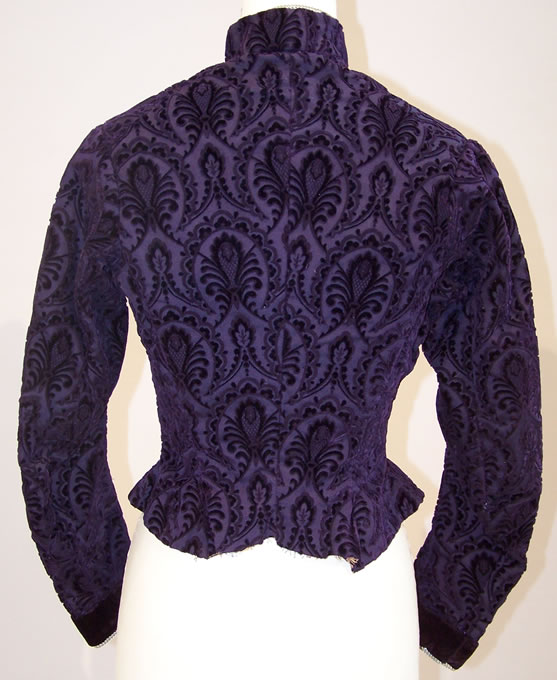
Sleeve
This bodice has a two-piece close-fitting sleeve with a ruched detail at the elbow (the back elbow fullness is gathered to the front panel). There is a seam just below the elbow and were sewn together by machine. Attention was paid to meticulously match the pattern of the brocade. This creative cutting was typically performed to eliminate fabric waste. The solid velvet cuffs are 1 1/2" wide with a 1.2 " opening at the bottom edge. The cuffs are lined with bluepolished cotton. Off white and olive dimensional woven trim is loosely hand stitched on the cuffs with a 1/4" running stitch. This trim is also stitched in the same fashion on the collar.
Closure and Boning
There are eleven hand-bound buttonholes and eleven velvet covered buttons on the front of the bodice. The button holes are 3/4" wide and are placed 1/4" from the center front opening. A piece of black faille measuring 1 3/4" reinforces the button holes and adds stability. This piece is hand stitched at center front and along the opposite edge. There is a flap, 1/2" wide silk ribbon, positioned at the waist and attached to the dart seam that has a hook and eye closure that meets at center front. This piece is fastened prior to buttoning the garment to help maintain a smooth surface. Bones are encased in twill tape and machine stitched to the dart seam allowance and the side seam allowance.
© Amy Page, 2010


